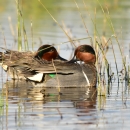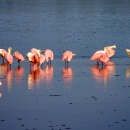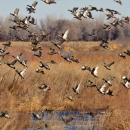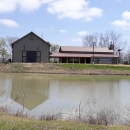About Us
Established in 1978, Panther Swamp NWR is noted for its large waterfowl population, resident game and its numerous sloughs and wetlands. Although limited archaeological evidence exists about the earliest inhabitants of the Lower Mississippi Delta, early Native Americans probably hunted, fished, and even farmed much of the area now included in the boundaries of Panther Swamp National Wildlife Refuge. Unlike the more nomadic tribes of the northern and western plains, the Yazoo Indians built small villages and retreated into the loessal bluffs along present-day Yazoo City only when forced to by rising flood waters. Many raised “Indian Mounds” can still be found throughout the Delta.
Our Mission
Refuge Purpose
Each unit of the National Wildlife Refuge System is established to serve a statutory purpose that targets the conservation of native species dependent on its lands and waters. All activities on those acres are reviewed for compatibility with this statutory purpose.
The Migratory Bird Conservation Act (16 U.S.C. 715-715d, 715e, 715f-715r) of February 18, 1929, (45 Stat. 1222) established a Migratory Bird Conservation Commission to approve areas recommended by the Secretary of the Interior for acquisition with Migratory Bird Conservation Funds. The Commission consists of the Secretary of the Interior (as chairman), the Secretaries of Transportation and Agriculture, two members of the Senate and two of the House of Representatives, and an ex-officio member from each State in which acquisition is being considered.
The Commission, through its chairman, is directed to report by the first Monday in December of each year to Congress on its activities during the preceding fiscal year. The Secretary of the Interior is authorized to cooperate with local authorities in wildlife conservation and to conduct investigations, to publish documents related to North American birds, and to maintain and develop refuges. The Act provides for cooperation with States in enforcement. It established procedures for acquisition by purchase, rental or gift of areas approved by the Commission for migratory birds.
Public Law 94-215, approved February 17, 1976, (90 Stat. 190) included in acquisition authority under the Act the purchase or rental of a partial interest in land or waters.
Public Law 95-552, approved October 30, 1978, (92 Stat. 2071) required that the Secretary of the Interior consult with the appropriate units of local government and with the Governor of the State concerned, or the appropriate State agency, before recommending an area for purchase or rental under the provisions of the Act. This provision was subsequently amended by P.L. 98-200, approved December 2, 1983 (97 Stat. 1378); P.L. 98-548, approved October 26, 1984 (98 Stat. 2774); and P.L. 99-645, approved November 10, 1986 (100 Stat. 3584) to require that either the Governor or the State agency approve each proposed acquisition.
Public Law 95-616, approved November 8, 1978, (92 Stat. 3110) authorized acquisition of areas for purposes other than inviolate sanctuary.
This Act, Refuge Recreation Act (16 U.S.C. 460k-460k-4) -- Public Law 87-714, approved September 28, 1962, (76 Stat. 653) as amended by Public Law 89-669, approved October 14, 1966, (80 Stat. 930) and Public Law 92-534, approved October 23, 1972, (86 Stat. 1063) authorized the Secretary of the Interior to administer refuges, hatcheries and other conservation areas for recreational use, when such uses do not interfere with the area's primary purposes.
The Act provided for public use fees and permits, and penalties for violation of regulations. It also authorized the acceptance of donations of funds and real and personal property to assist in carrying out its purposes.
Public Law 93-205, approved December 28, 1973 (87 Stat. 902), authorized acquisition of lands and interests suitable for: 1) fish and wildlife-oriented recreation, 2) protection of natural resources, 3) conservation of endangered or threatened species, or 4) carrying out two or more of the above. Such lands were required to be adjacent to or within an existing conservation area conservation area
A conservation area or wildlife management area is a type of national wildlife refuge that consists primarily or entirely of conservation easements on private lands. These conservation easements support private landowner efforts to protect important habitat for fish and wildlife. There are 15 conservation areas and nine wildlife management areas in the National Wildlife Refuge System.
Learn more about conservation area . Acquisition was not permitted with "duck stamp" receipts for these purposes.
Enforcement provisions were amended by Public Law 95-616, approved November 8, 1978 (92 Stat. 3110), and were further revised by Public Law 98-473, approved October 12, 1984 (98 Stat. 2028, 2031), which made violations misdemeanors in accordance with the uniform sentencing provisions of that law (18 U.S.C. 3551-3586).
Other Facilities in this Complex
Panther Swamp National Wildlife Refuge is one of nine refuges that make up the Theodore Roosevelt National Wildlife Refuge Complex and it serves as the Headquarters for the Complex. Each refuge in the Complex plays vital role to conserving our nation's resources. A National Wildlife Refuge Complex is an administrative grouping of two or more Refuges, wildlife management areas or other Refuge conservation areas that are primarily managed from a central office location. Refuges are grouped into a complex structure structure
Something temporarily or permanently constructed, built, or placed; and constructed of natural or manufactured parts including, but not limited to, a building, shed, cabin, porch, bridge, walkway, stair steps, sign, landing, platform, dock, rack, fence, telecommunication device, antennae, fish cleaning table, satellite dish/mount, or well head.
Learn more about structure because they occur in a similar ecological region, such as a watershed or specific habitat type, and have a related purpose and management needs. Typically, a Project Leader oversees the general management of all Refuges within the complex and Refuge Managers are responsible for operations at specific Refuges. Supporting staff, composed of administrative, law enforcement, Refuge manager, biological, fire, visitor services, and maintenance professionals, are centrally located and support all Refuges within the complex.
Checkout the list below of the other Refuges within the Complex, and visit each one for new and different experiences!








